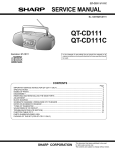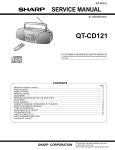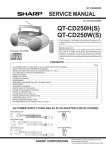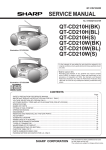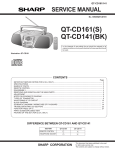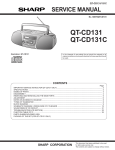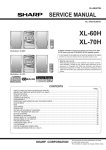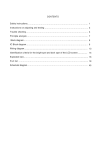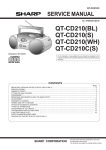Download Sharp QT-CD110H Service manual
Transcript
QT-CD111H/110H SERVICE MANUAL No. S6844QTCD111H QT-CD111H QT-CD110H QT-CD110H is different from QT-CD111H in Control Panel color. Illustration: QT-CD111H • In the interests of user-safety the set should be restored to its original condition and only parts identical to those specified should be used. • Note for users in UK Recording and playback of any material may require consent which SHARP is unable to give. Please refer particularly to the provisions of Copyright Act 1956, the Dramatic and Musical Performers Protection Act 1956, the Performers Protection Acts 1963 and 1972 and to any subsequent statutory enactments and orders. CONTENTS Page SAFETY PRECAUTION FOR SERVICE MANUAL ........................................................................................................... 2 IMPORTANT SERVICE NOTES (111H FOR UK ONLY) .................................................................................................. 3 SPECIFICATIONS ............................................................................................................................................................. 3 NAMES OF PARTS ........................................................................................................................................................... 4 DISASSEMBLY .................................................................................................................................................................. 5 REMOVING AND REINSTALLING THE MAIN PARTS ..................................................................................................... 6 ADJUSTMENT ................................................................................................................................................................... 7 NOTES ON SCHEMATIC DIAGRAM ................................................................................................................................ 9 TYPES OF TRANSISTOR ................................................................................................................................................. 9 BLOCK DIAGRAM ........................................................................................................................................................... 10 SCHEMATIC DIAGRAM / WIRING SIDE OF P.W.BOARD ............................................................................................. 12 WAVEFORMS OF CD CIRCUIT ...................................................................................................................................... 18 TROUBLESHOOTING (CD SECTION) ........................................................................................................................... 19 FUNCTION TABLE OF IC ................................................................................................................................................ 22 PARTS GUIDE/EXPLODED VIEW PACKING METHOD (111H FOR UK ONLY) SHARP CORPORATION –1– This document has been published to be used for after sales service only. The contents are subject to change without notice. QT-CD111H/110H SAFETY PRECATION FOR SERVICE MANUAL Laser Diode Properties Material: GaAIAs Wavelength: 780 nm Emission Duration: continuous Laser Output: max. 0.6 mW Precaution to be taken when replacing and servicing the Laser Pickup. The ael (ACCESSIBLE EMMISSION LEVEL) of the laser power output is less than class 1 but the laser component is capable of emitting radiation exceeding the limit for class 1. Therefore it is important that the following precautions are observer during servicing to protect your eyes against exposure to the laser beam. (1) When the cabinet is removed, the power is turned on without a compact disc in position and the pick-up is on the outer edge the laser will light for several seconds to detect a disc. Do not look into the pick-up lens. (2) The laser power output of the pick-up unit and replacement service parts are all factory pre-set before shipment. Do not attempt to re-adjust the laser pick-up unit during replacement or servicing. (3) Under no circumstances stare into the pick-up lens at any time. (4) CAUTION-USE of controls or adjustments, or pereformance of procedures other than those specified herein may result in hazardous radiation exposure. (111H For UK) CAUTION-INVISIBLE LASER RADIATION WHEN OPEN. DO NOT STARE INTO BEAM OR VIEW DIRECTLY WITH OPTICAL INSTRUMENTS. VARNING-OSYNLIG LASERSTRALNING NAR DENNA DEL AR OPPNAD. STIRRA EJ IN I STRALEN OCH BETRAKTA EJ STRALEN MED OPTISKA INSTRUMENT. ADVERSEL-USYNLIG LASERSTRALING VED ABNING. SE IKKE IND I STRALEN-HELLER IKKE MED OPTISKE INSTRUMENTER. (111H Except for UK/110H) VARO! AVATTAESSA OLET ALTTIINA NAKYMATON LASERSATEILYLLE. ALA TUIJOTA SATEESEEN ALAKA KATSO SITA OPTISEN LAITTEEN LAPI. VARNING-OSYNLIG LASERSTRALNING NAR DENNA DEL AR OPPNAD. STIRRA EJ IN I STRALEN OCH BETRAKTA EJ STRALEN GENOM OPTISKT INSTRUMENT. ADVERSEL-USYNLIG LASERSTRALING NAR DEKSEL APNES. STIRR IKKE INN I STRALEN ELLER SE DIREKTE MED OPTISKE INSTRUMENTER. VAROITUS! LAITTEEN KÄYTTÄMINEN MUULLA KUIN TÄSSÄ KÄYTTÖOHJEESSA MAINITULLA TAVALLA SAATTAA ALTISTAA KÄYTTÄJÄN TURVALLISUUSLUOKAN 1 YLITTÄVÄLLE NÄKYMÄTTÖMÄLLE LASERSÄTEILYLLE. VARNING - OM APPARATEN ANVÄNDS PÅ ANNAT SÄTT ÄN I DENNA BRUKSANVISNING SPECIFICERAS. KAN ANVÄNDAREN UTSÄTTAS FÖR OSYNLIG LASERSTRÅLNING, SOM ÖVERSKRIDER GRÄNSEN FÖR LASERKLASS 1. LASER KLASSE 1 LUOKAN 1 LASERLAITE KLASS 1 LASERAPPARAT –2– QT-CD111H/110H FOR A COMPLETE DESCRIPTION OF THE OPERATION OF THIS UNIT, PLEASE REFER TO THE OPERATION MANUAL. IMPORTANT SERVICE NOTES (111H FOR UK ONLY) Before returning the unit to the customer after completion of a repair or adjustment it is necessary for the following withstand voltage test to be applied to ensure the unit is safe for the customer to use. Setting of Withstanding Voltage Tester and set. Set name Set value Withstanding Voltage Tester Test voltage WITHSTANDING VOLTAGE TESTER 4,240 VPEAK 3,000 VRMS 6 secs Set time Set current (Cutoff current) Unit Judgment PROBE AC OUT 4 mA UNIT SHORT-CIRCUT AC POWER SUPPLY CORD OK: The “GOOD” lamp lights. NG: The “NG” lamp lights and the buzzor sounds. CONNECT THE PROBE TO GND OF BATTERY SPRING SPECIFICATIONS General Power source: Power consumption: Output power: (111H Except for UK/ 110H) Output power: (111H For UK) Speakers: Output terminal: Dimensions: Weight: Tape recorder AC 230 - 240V, 50 Hz DC 12 V [ "D" size (UM/SUM-1, R20 or HP-2) battery x 8] 11 W PMPO; 28 W MPO; 8.4 W (4.2 W + 4.2 W) (AC operation, DIN 45 324) RMS; 4.6 W (2.3 W + 2.3 W) (DC operation, DIN 45 324) MPO (Max.); 8.4 W (4.2 W + 4.2 W) (AC operation) RMS; 4.6 W (2.3 W + 2.3 W) (DC operation, 10 % T.H.D.) 10 cm (4") full-range speaker x 2 Headphones; 16-50 ohms (recommended; 32 ohms) Width; 480 mm (18-15/16") Height; 153 mm (6-1/16") Depth; 254 mm (10") 3.2 kg (7.1 Ibs.) without batteries Frequency response: 50 - 14,000 Hz (Normal tape) Signal/noise ratio: 50 dB Wow and flitter: 0.3 % (DIN 45 511) (111H Except for UK/110H) Wow and flitter: 0.25 % (WRMS) (111H For UK) Motor: DC 12 V electric governor Bias system: AC bias Erase system: Magnet erase Compact disc player Disc: Signal readout: Audio channels: Quantization: Filter: D/A converter: Wow and flutter: Radio Frequency range: Compact disc Non-contact, 3-beam semiconductor laser pickup 2 16-bit linear quantization 4-tims oversampling digital filter 1-bit D/A converter Unmeasurable (less than 0.001% W. peak) Specifications for this model are subject to change without prior notice. FM; 87.5 - 108 MHz AM; 526.5 - 1,606.5 kHz –3– QT-CD111H/110H NAMES OF PARTS 1 1. Cassette Compartment 2. CD Compartment 3. Tuning Control 4. (TAPE) Record Button: 5. (TAPE) Play Button: 6. (TAPE) Rewind Button: 7. (TAPE) Fast Forward Button: 8. (TAPE) Stop/Eject Button: / 9. (TAPE) Pause Button: 10. CD Eject Button: 2 3 4 5 6 7 8 9 10 11 12 11. (CD) Play Indicator: 12. (CD) Track Number Indicator 13. (CD) Repeat Indicator: 14. Volume Control 15. Stand-by,On/Function Selector Switch 16. Extra Bass Button: X-BASS 17. (CD) Track Down/Review Button: 18. (CD) Track Up/Cue Button: 19. (CD) Stop Button: 20. (CD) Play/Repeat Button: 13 14 15 16 17 18 19 20 21 22 21. FM Telescopic Rod Aerial 22. Headphones Socket 23. Battery Compartment 24. AC Power Input Socket 23 –4– 24 QT-CD111H/110H DISASSEMBLY Caution on Disassembly Follow the below-mentioned notes when disassembling the unit and reassembling it, to keep it safe and ensure excellent performance: 1. Take cassette tape and compact disc out of the unit. 2. Be sure to remove the power supply plug from the wall outlet before starting to disassemble the unit. 3. Take off nylon bands or wire holders where they need be removed when disassembling the unit. After servicing the unit, be sure to rearrange the leads where they were before disassembling. 4. Take suffcient care on static electricity of integrated circuits and other circuits when servicing. STEP PROCEDURE FIGURE 1 Rear Cabinet REMOVAL 1. Screw ................. (A1) x10 2. Socket .................. (A2) x1 5-1 5-2 2 Top Cabinet 1. Knob ..................... (B1) x1 (with CD Mechanism/ 2. Screw ................... (B2) x3 Tape Mechanism/ 3. Socket .................. (B3) x1 Main PWB/ Headphones PWB) 5-2 3 Headphones PWB 1. Screw .................. (C1) x2 5-3 4 Main PWB/ Switch PWB 1. Screw ................... (D1) x6 2. Socket .................. (D2) x4 5-3 5-3,5-4 5 Tape Mechanism 1. Screw ................... (E1) x4 5-4 6 CD Mechanism 1. Screw ................... (F1) x3 5-4 7 Terminal PWB 1. Screw ................... (G1) x5 2. Hook ..................... (G2) x1 5-5 (D1)x5 ø3x10mm (D2)x1 Switch PWB (C1)x2 ø3x10mm Main PWB Headphones PWB Top Cabinet (D1)x1 ø3x10mm Figure 5-3 (E1)x4 ø3x10mm (F1)x3 ø2.5x10mm Tape Mechanism Front Cabinet (D2)x2 Top Cabinet CD Mechanism (D2)x1 Figure 5-4 (A1)x6 ø3x20mm (G2)x1 (A1)x3 ø3x12mm Rear Cabinet (A1)x1 ø3x12mm Push Figure 5-1 Driver Top Cabinet (B1)x1 (G1)x2 ø3x12mm Spacer PWB (G1)x1 ø3x10mm Terminal PWB (B2)x3 ø3x12mm Main PWB (A2)x1 (B3)x1 Headphones Front Cabinet PWB Figure 5-2 (G1)x2 ø3x14mm Figure 5-5 –5– QT-CD111H/110H REMOVING AND REINSTALLING THE MAIN PARTS CD MECHANISM SECTION Perform steps 1, 2, 4 and 6 of the disassembly method to remove the CD mechanism. (A1) x2 2.6 x6mm How to remove the pickup (See Fig. 6.) 1. Remove the screws (A1) x 2 pcs., to remove the shaft (A2) x1 pc. 2. Remove the stop washer (A3) x1 pc., to remove the gear (A4) x 1 pc. 3. Remove the pickup. CD Mechanism Pickup Shaft (A2) x1 Gear (A4) x1 Figure 6 –6– Stop Washer (A3) x1 QT-CD111H/110H ADJUSTMENT MECHANISM SECTION TUNER SECTION • Driving Force Check fL: Low-range frequency fH: High-range frequency Torque Meter Specified Value PLAY: TW-2412 • FM IF/RF Over 120 g Specified Value/Adjusting Point Test Stage • Torque Check Torque Meter Specified Value Play: TW-2111 25 to 65 g.cm IF T1 Fast Forward: TW-2231 60 to 130 g.cm Detection T2 Rewind: TW-2231 60 to 130 g.cm Band Coverage fL: L2 fH: TC2 Tracking 88.0 MHz: L1 108.0 MHz: TC1 • Head Azimuth Torque Meter Specified Value MTT-114 Output: Speaker Terminal (CNP201 Load resistance: 8 ohms) Test Stage Adjusting Point MTT-111 In motor Specified Value Instrument Connection 3,000 ± 90 Hz Output: Speaker Teaminal (CNP201 Load resistance: 8 ohms) Input: Pin 1 of IC1 Output: Pin 17 of IC2 Iuput: Antenna Output: Speaker Terminal (CNP201 Load resistance: 8 ohms) • AM IF/RF • Tape Speed Test Tape Instrument Connection Instrument Connection Specified Value/Adjusting Point IF T3 Input: Antenna Output: Pin 19 of IC2 Band Coverage fL: L4 fH: TC4 600 kHz: L3 1,400 kHz: TC3 Input: Antenna Output: Speaker Terminal (CNP201 Load resistance: 8 ohms) Tracking TAPE SECTION Position of each switch or control Volume control Function switch X-BASS • VCO Frequency Max Tape/Power Off On • Bias Oscillation Adjustment Point Specified Value MTT-118 1.8 V ± 3 dB Pin 13 of IC2 Pin 13, pin 21 and ground of IC2 Note: After preparing the test circuit shown in Fig. 7-1, connect the Pin 13, Pin 21 and ground of the IC2 with the test circuit, and measure the value. At this time, apply a standard unmodulated signal input and adjust the VCO. Pin 2 of CNP201 • Playback Amplifier Sensitivity Check Test Tape Instrument Connection 76 kHz ± 200 Hz VR1 Instrument Connection Specified Value 82 kHz ± 6 kHz – 6 kHz L301 Specified Value Adjusting Point Instrument Connection Speaker Terminal (Load resistance: 8 ohms) MAIN PWB AM TRACKING fL FM ROD ATENNA Pin 21 of IC2 VR1 VCO 13 TO FREQUENCY COUNTER S NA D TEN G FET : 2SK19 or 2SK54 L AR A3 N 10 kohm T2 17 19 IC2 T3 21 1 L4 AM IF AM B Figure 7-1 VCO FREQUENCY TEST CIRCUIT FM DETECTION L2 IC1 TC4 T1 TC2 TC3 AM TRACKING fH fL fH AM BAND COVERAGE FM IF TC1 L1 fL fH FM TRACKING 1 fL fH FM BAND COVERAGE Figure 7-2 ADJUSTMENT POINTS –7– QT-CD111H/110H CD SECTION Since this CD system incorporates the following automatic adjustment function, when the pickup is replaced, it is necessary to reajust it. Since this CD unit does not need adjustment, the combination of PWB and laser pickup unit is not restricted. TEST MODE Start While holding down the "STOP" button, move the FUNCTION/POWER switch to "CD". Then, release the "STOP" button and, within 0.5 second, connect the TEST POINT to GND (within 0.5 second). (See Fig. 8) Note 1. When the CD LID switch is in the OFF position, the unit will be able to enter the test mode. However, playback cannot be performed in this mode. 2. You can only move the pickup. 3. The LCD display should be the same as it is for normal CD operations. Operation 1 The use of the "UP/CUE" button will move the pickup to the outermost position. The use of the "DOWN/REVIEW" button will move the pickup to the innermost position. 2 When the "PLAY" button is pressed, the laser will be lit, and when the "STOP" button is pressed, it will be turned off. Playback will also start and stop when these buttons are pressed. a. If the "PLAY" button is pressed while in the stop mode, the laser will simply be turned on at first. b. If the laser is lit and the "PLAY" button is pressed again, playback will start from the current pickup position. c. If the "STOP" button is pressed, playback will stop. When pressed again, the laser will be turned off. 3 Turning the tracking servo on or off. a. Each time the PAUSE button is pressed during playback, the tracking servo will be turned on or off. (Note: If the PLAY button is pressed while in the stop mode, the tracking servo will automatically be turned on.) LCD MODE Start Display While holding down the "STOP" button, move the FUNCTION/POWER switch to "CD". Then, release the "STOP" button and, within 0.5 second, press the REVIEW/DOWN button. 2 1 1 second 3 3 1 second 12 3 * After the number has appeared in the display, each time the "UP/CUE" button is pressed, the display will switch in the following order: , , and then . SWITCH PWB – A2 R771 3.9K SW774 TRACK DOWN/ REVIEW R772 2.7K SW773 TRACK UP/ CUE TEST POINT R773 1.8K R774 1.5K R776 10K SW771 PLAY SW7712 STOP +B 3 1 TO CD SECTION Figure 8 –8– QT-CD111H/110H NOTES ON SCHEMATIC DIAGRAM • Resistor: To differentiate the units of resistors, the symbol as K and M are used: the symbol K means 1000 ohm and the symbol M means 1000 kohm and the resistor without any symbol is an ohm resistor. The resistor designated "Fusible" is a fuse type resistor • Capacitor: To indicate the unit of capacitor, a symbol P is used: this symbol P means micro-micro-farad and the unit of the capacitor without such a symbol is microfarad. As to electrolytic capacitor, the expression “capacitance/withstand voltage” is used. (CH), (TH), (RH), (UJ): Temperature compensation (ML): Mylar type (P.P.): Polypropylene type • The indicated voltage in each section is the one measured by Digital Multimeter between such a section and the chassis with no signal given. REF. NO DESCRIPTION 1. Tuner ( ): AM mode Marking except for ( ): FM mode 2. CD ( ): Play mode Marking except for ( ): Stop state 3. Deck section ( ): Record mode Marking except for ( ): Playback mode Display / Control section: ( ): Active state Marking except for ( ): CD Function mode at stop state • Schematic diagram and Wiring Side of P.W.Board for this model are subject to change for improvement without prior notice. • Parts marked with “ ”( ) are important for maintaining the safety of the set. Be sure to replace these parts with specified ones for maintaining the safety and performance of the set. POSITION REF. NO DESCRIPTION POSITION SW102 RECODE/PLAYBACK OFF—ON SW761 CD LID OPEN/CLOSE OFF—ON SW201 FUNCTION/POWER TAPE—AM— FM AUTO—CD/ OFF—ON SW771 PLAY/REPEAT OFF—ON SW772 STOP OFF—ON SW773 TRACK UP/CUE OFF—ON SW774 TRACK DOWN/REVIEW OFF—ON SW203 X-BASS OFF—ON SW601 TAPE MAIN OFF—ON SW702 PICKUP IN OFF—ON FRONT VIEW E C B (S) (G) (D) (1) (2) (3) 2SC1815 GR Figure 9 TYPES OF TRANSISTOR –9– 24 27 28 30 31 34 35 36 SEG4 57 ~ 60 SEG1 ~ 9 ~ 14 17 ~ 19 21 20 SL+ SL– +5V (D) PU-IN SW 13 14 38 25 VLC3 VDD SYSTEM MICROCOMPUTER 37 LID 23 33 22 44 IC701 IX0105AW 41 COM3 X701 4MHz COM0 RES PICKUP IN SW702 Figure 10 BLOCK DIAGRAM (1/2) – 10 – M702 SLIDE MOTOR M701 SPIN MOTOR TRACKING COIL FOCUS COIL PICKUP UNIT M M 17 18 26 27 11 12 1 2 30 31 1 2 3 4 SL– SL+ FIN2 FIN1 E F Q804 IC804 BA5914FP 10 19 23 25 JP– 44 43 40 32 9 EFMO IC802 EFMIN LCHO CLV+ LC78622E 13 CLV– SERVO/SIGNAL 14 V/P CONTROL 15 HFL 16 TES 17 TOFF 18 TGL 19 JP+ 20 JP– RES. CQCK. COIN SQOUT. RWC. WRQ 2 4 8 11 1 61 58 57 56 55 54 53 13 28 5 6 7 8 22 2 +7.4V CONSTANT VOLTAGE REGULATOR CL, DAT, SELIAL CONTROL 49 50 51 52 53 54 FOCUS/TRACKING /SPIN/SLIDE DRIVER 3 +5V 15 16 27 28 29 SLI SLC CV+ 10 12 6 45 44 23 43 +5V 62 XL801 16.93MHz 64 IC801 LA9240M SERVO AMP. Q805 LASER +5V DRIVER LDO VCC1 LCD701 CD LCD K1 XIN SL– DRF XOUT CD OPERATION KEY SW771~SW774 TO FD SPO SLEO SLD XOUT WRQ RESET XIN ~ VVDD VDD XVDD THLD/DEF CLK CL DAT CE DRF CD LID OPEN/CLOSE SW761 46 39 38 33 32 37 64 63 62 51 +7.4V (CD) R-CH GND (A) L-CH +7.4V (D) GND (D) 6 POWER GND 7 MUTE 1 2 3 4 5 TO MAIN SECTION QT-CD111H/110H Figure 11 BLOCK DIAGRAM (2/2) – 11 – L-CH ERASE HEAD R-CH REC / PB HEAD FROM CD SECTION 1 L1 FM RF 2 3 9 6 FM +B 7 SW102-H REC / PB SW102 REC / PB B.D REC / PB SW102 C,E P.B P.B MUTE R-CH 1 (AUDIO GND) 2 CD L-CH 3 +7.4V 4 +B2 5 (DIGITAL GND) 6 (POWER GND) 5 VCC MIX 8 4 7 BIAS OSC. P. B REC SW102-G REC / PB 8 6 R 12 9 R IC101 EQULIZER AMP. BA331IL L 1 REG. 23 5 REC SW601 MAIN +B2 STANBY VR201 A,B AM / FM SELECT +B FM +B 14 10 5 11 6 R 2 L 8 TUNER +B TRIG. VCO 7 ST. SWIT. FF ST. DRIV. SP502 R-CH SPEAKERS SP501 L-CH AC 230-240V 50Hz AC INPUT SO651 FF FF VCC 21 TUNER +B BATTERY DC12V [' D' SIZE (UM/SUM-1, R20 or HP-2)BATTERYx8] 10 12 IC501 LA4597 POWER AMP. 9 DECODER PHASE DET. PILOT DET. 11 13 15 VR1 VCO T651 POWER TRANSFORMER 15 AM / FM SELECT +B 19 18 VOLUME 8 TU DRIV. SW201-C POWER/ FUNCTION +B1 12 MUTE POST AMP. D651~D654 RECTIFIER IC203 KIA7808P VOLTAGE REGULATOR Q201 Q202 SW203 A,B 4 AGC DET. DET. 20 17 T2 FM DET TAPE 6 GND AM - IF LEVEL - DBT. FM - IF 2 CP 455kHz X-BASS SW201-D POWER / FUNCTION L5 AM OSC 24 OSC MPX 3 T3 AM IF RADIO M601 TAPE MOTOR RF 1 22 CF 10.7MHz IC2 LA1805 FM / AM IF MPX. +B1 T1 FM IF EC / PB SW102 A,F POWER/ FUNCTION SW201-A,B 5 L C201 L201 REC REC P.B L2 FM OSC OSC IC1 LA1186N FM FRONT END RF AMP L3 AM BAR ANT. F1 B.P.F FM ROD ANTENNA QT-CD111H/110H QT-CD111H/110H IC701 VOLTAGE PIN NO. VOLTAGE 0V 33 5V 0V 34 0V 0V 35 0V 0V 36 0V 0V 37 0.4V 0V 38 5V 3.9V 39 3.1V 0V 40 1.5V 5V 41 2.4V 4.1V 42 2.4V 4.1V 43 2.4V 0V 44 2.4V 0V 45 2.4V 0V 46 2.4V 0.4V 47 2.4V 0.4V 48 2.4V 0V 49 2.4V 0V 50 2.4V 0V 51 2.4V 0V 52 2.4V 5V 53 2.4V 54 2.4V 2.5V 55 2.4V 2.5V 0V 56 2.4V 5V 57 2.4V 5V 58 2.4V 0V 59 2.4V 0V 60 2.4V 5V 61 2.4V 4.8V 62 0V 0V 63 0V 3.8V 64 0V SWITCH PWB-A2 SW774 TRACK DOWN/ REVIEW Q805 S9012H +B SW773 TRACK UP/ CUE R842 22 C849 0.022 C848 1/50 SW771 PLAY/ REPEAT 3 1 3 1 C837 10/16 +B C838 0.01 R776 10K C835 0.1/50 +B SW761 CD LID OPEN/CLOSE C839 1/50 SW772 STOP C840 0.33/50 B PIN NO. 1 2 3 4 5 6 7 8 9 10 11 12 13 14 15 16 17 18 19 20 21 22 23 24 25 26 27 28 29 30 31 32 R774 R773 R772 R771 1.5K 1.8K 2.7K 3.9K A 1 2 3 4 5 6 7 8 9 10 11 12 13 14 15 16 D740 1N4148 R721 15K R724 15K +B R716 10K VCC2 FSS CL CLK REFI DEF VR CE DAT LF2 DRF BH1 R741 3.3K Q740 2SC1815 GR R744 R740 10K 4.7K R745 10K R827 220K R824 10K C819 47/16 +B PIN NO. 1 2 3 4 5 6 7 8 9 10 11 12 13 14 15 16 17 18 19 20 21 22 C741 3.3/50 R743 100K D741 1N4148 CD SIGNAL G VOLTAGE PIN NO. 23 2.5V 2.5V 24 2.5V 25 2.5V 26 2.5V 27 28 2.5V 2.5V 29 2.5V 30 2.5V 31 2.5V 32 2.5V 33 2.5V 34 2.5V 35 2.5V 36 2.5V 37 38 2.5V 2.5V 39 40 2.5V 41 2.5V 42 2.5V 43 2.5V 44 0V IC801 VOLTAGE PIN NO. 2.5V 45 2.5V 46 2.5V 47 2.5V 48 2.5V 49 2.5V 50 2.5V 51 2.2V 52 2.2V 53 0V 54 0V 55 5V 56 5V 57 4.8V 58 0V 59 5V 60 0V 61 0V 62 1.5V 63 2.4V 64 2.5V 2.5V VOLTAGE 0V 2.5V 2.5V 0V 0V 2.4V 4.1V 4.7V 0V 0V 5V 5V 2.5V 2.5V 0.9V 0.9V 2.1V 4.2V 0V 5V PIN NO. 1 2 3 4 5 6 7 8 9 10 11 12 13 14 15 16 17 18 19 20 21 22 IC802 PIN VOLTAGE PIN NO. VOLTAGE NO. VOLTAGE 23 5V 0V 45 2V 0V 24 0V 46 0V 1.5V 25 0V 47 0.1V 0V 26 0V 48 2.2V 2V 27 0V 49 0V 28 0V 5V 50 2.5V 0.3V 29 0V 51 0V 0V 30 5V 52 2.5V 2.5V 31 2.5V 53 0V 54 0V 2.5V 32 0V 55 0V 0V 33 0V 34 0V 0V 56 4.1V 35 5V 0V 57 4.1V 36 4.7V 5V 58 5V 37 2V 0V 59 0V 38 60 2.7V 4.8V 0V 39 5V 61 2.4V 0V 40 2V 5V 62 0V 41 4.7V 0V 63 0V 42 0V 0V 64 0V 43 5V 2.5V 44 2.3V 0V MAIN PWB(2/2) H • The numbers 1 to 12 are waveform numbers shown in page 18. 1 2 3 4 Figure 12 SCHEMATIC DIAGRAM (1/4) – 12 – 5 R833 5.6K R8 47K R832 56K R 4 C8 220 R 8 C 5V DIGITAL GND PU IN WRQ SQOUT DRF SL– SL+ RWC CO IN CQCK RES R742 1K C8 0.1 30 31 32 +B +B C845 4.7/50 SL+ JP– SLD R822 6.8K SL– SPD SLEQ 29 R715 15K R727 1K +B R718 15K R719 15K R720 15K R722 15K R723 15K R725 15K PH1 C811 0.1 R736 1K C740 0.01 R815 C814 R816 47K 0.01 1.5K R840 22K X701 4MHz R726 1K R728 1K R729 1K R731 1K R732 1K R733 1K R735 1K F VREF 27 28 R831 1K R713 1K R839 22K R817 82K TOFF 35 34 33 C820 R826 0.0033 220K GND 25 26 C818 1/50 C705 0.022 24 C830 2P (CH) CV+ 40 CV– 39 SLOF 38 HFL 37 TES 36 R825 1.2K VSS XOUT XIN 18 SQOUT P21 RESET 17 DFR P20 PU-IN P23 WRQ P22 R812 C813 R828 15K 0.1 1K R829 1K 21 22 23 C812 330P R813 33K +B C816 0.001 15 16 17 18 19 20 R714 10K C704 100/10 R730 1K P33 COM2 COM3 VLC1 VLC2 VLC3 KIDSW AIN7 SIMUKE AIN6 AIN5 P3P40 XCOUT VDD 32 31 30 29 28 27 26 25 24 23 22 21 20 19 18 17 R734 1K P00 P01 P02 IC701 IX0105AW SYSTEM MICROCOMPUTER VREF AVSS XCIN D3 RES D4 COCK D5 COIN D6 RWC D7 SL+ D8 SL– SEG2 SEG1 SEG0 32 P32 31 P31 30 P30 D1 MUTE SEG7 SEG6 SEG5 SEG4 SEG3 P10 POWER IN E SEG10 SEG9 SEG8 SEG16 COM0 COM1 48 47 46 45 44 43 42 41 40 39 38 37 36 35 34 33 SEG12 SEG11 RFSM 41 TD 13 JP 14 C817 0.47/50 R830 1K R811 3.3K SLC 43 RFS– 42 34 TGL 33 JP+ SP– C810 180P D 49 50 51 52 53 54 55 56 57 58 59 60 61 62 63 64 15 TO 16 FD 12 TD– R821 56K R711 2.7K C808 0.068 SPG R710 10K C809 0.047 R808 12K 10 TH TA 11 R820 10K R807 1K R809 27K R709 1K 9 SCI R823 1.2K 1 C833 0.001 IC801 LA9241M SERVO AMP. 8 TESI SP 2 48 NC TBC 47 FSC 46 GND 45 SLI 44 C815 0.0047 3 R871 4.7K C834 0.033 A GND 4 50 49 1 FIN2 2 FIN1 NC 5 2 3 E 4 F 5 TB FE– 6 56 55 54 53 52 51 7 TE C806 0.033 R806 100 57 6 TE– C805 0.033 C807 0.1/50 R805 6.8K 58 R814 10K 7 R708 1K 8 C701 0.022 C702 0.022 +B 59 R819 39K LCD701 R802 100K R804 2.2K 61 60 FE C804 0.001 62 FA– C R803 15K 63 FA C803 0.1/50 64 LDS 1 LDD 2 FD– 1 VCC1 FW701 6 +B F E B A K C802 47/16 R801 1K 1 2 3 4 5 6 7 8 TR– TR+ FO+ FO– GND PD TR+ FO+ FO– TR+ FO+ VR LD FO– TR– TR– PICKUP UNIT C867 10/16 TEST3 LVDD 36 MUTEL 35 34 R873 100 C870 0.0022 R875 R876 10K 10K C868 R874 10/16 100 LVSS 38 DOUT 1 2 3 4 5 6 7 8 +B +B LCHO 37 C2F EMPH CONT5 CONT4 CONT3 CONT2 B F C869 0.0022 C890 100/10 33 R880 100 24 25 26 27 28 29 30 31 32 SL+ JP– 17 18 19 20 21 22 23 K E A E A B F XL801 16.93MHz XVSS 46 XIN 45 34 NC 33 TEST4 15 HFL 16 TES BI801 TR+ TR– FO– FO+ PW FSX SFSY SBCK RWC WRQ COIN SQOUT RES CQCK 16M TST11 4.2M CS 12 CLV+ 13 CLV– 14 V/P– 15 16 C822 220P OFF 35 34 33 47 RVSS 39 CONT1 C831 0.0027 R835 470 Vss VDD R832 56K CV+ 40 CV– 39 LOF 38 HFL 37 TES 36 48 EFLG 47 SBSY MON K 48 XOUT 44 EMFO 10 EMFIN 11 TEST2 R834 1K 1 2 3 4 5 6 7 8 53 52 51 50 49 XVDD 43 IC802 MUTER 42 RVDD 41 LC78623D RCHO 40 SERVO/SIGNAL CONTROL FSEQ C832 27P (CH) 55 54 VVDD FR PCK FSM 41 C830 2P (CH) R833 5.6K R857 27K 6 7 R856 1.2K 8 9 R837 47K 57 56 1 DEFI 2 TAI 4 VVss 5 ISET JP– SLC 43 FS– 42 R836 47K 62 61 60 59 58 1 C841 2 0.047 3 PDO C842 0.047 R838 33K C834 0.033 C833 0.001 64 63 TEST5 R858 680 JP+ C845 4.7/50 TGL 48 NC TOFF DEF 49 TBC 47 FSC 46 GND 45 SLI 44 +B +B TEST1 +B C850 0.1 5 4 3 2 1 LD 1 VR C C801 0.01 R860 1K C847 0.01 5 4 3 2 1 LD PD CNS801 +B R871 4.7K 5 4 3 2 1 CNS802 BI802 QT-CD111H/110H 31 32 +B C843 100/10 C873 0.01 TR+ TR– FO– FO+ +B R849 100K R827 220K +B D802 1N4148 R810 82K L801 0.82µH C851 0.022 CNP803 C821 1/50 2.5V 2.5V Q804 R877 220 7.4VS8050D4.8V +B VOLTAGE R878 100 2V 0V 0.1V 2.2V 0V 2.5V 0V 2.5V 0V 0V 0V 4.1V 4.1V 5V 0V 2.7V 2.4V 0V 0V 0V +B 5.5V -3.2V 9 VIN2' VIN2 10 VO2+ 11 VO212 0V 13 GND 14 OP OUT C889 10/16 2.5V 7.4V BIAS IN 23 VCC 22 30 VCC 21 +B 6 6 5 5 5 4 4 4 3 3 3 2 2 2 1 1 1 M M701 SPINDLE MOTOR M M702 SLED MOTOR SW702 PICKUP IN CD MOTOR PWB-B +B 7.4V VIN3' 20 19 VIN3 VO3+ 18 VO3– 17 2.7V 3.8V 3.2V OP IN + 16 OP IN - 15 ZD801 MTZJ5.6B C887 0.022 SL– PU-IN VIN4' 24 6 +B L802 0.68µH MUTE POWER GND DIGITAL GND DIGITAL +7.4V L-CH AUDIO GND R-CH N O. 5 6 7 8 9 0 1 2 3 4 5 6 7 8 9 0 1 2 3 4 +3.8V 0V 8 GND SL+ BI803 29 SP– 3.5V 3.5V 2.5V CNS803 0V C846 330/10 SP+ 0V C844 330/10 4 VIN1' 0V 5 NC 0V 6 NC 0V 7 MUTE GND 28 VO4– 27 VO4+ 26 VIN4 25 0V 3.5V 1 VO13.5V 2 VO1+ 2.5V 3 VIN1 IC804 BA5914FP FOCUS/TRACKING/SPIN/SLIDE DRIVER +B 7 6 5 4 3 2 1 P14 1 - E TO MAIN SECTION • NOTES ON SCHEMATIC DIAGRAM can be found on page 9. 7 8 9 10 Figure 13 SCHEMATIC DIAGRAM (2/4) – 13 – 11 12 QT-CD111H/110H A R5 330K 2 CF2 C21 0.022 C28 0.0015 (Styrol) C33 1/50 C34 1/50 R13 3.3K R14 3.3K VCO AM/FM SW201-A CD AUTO FM AM TAPE VC3 fH AM fL TRACKING VC4 L4 AM OSC. fH fL AM BAND COVERAGE R456 6.8K 1 2 3 4 5 6 7 R455 6.8K R229 10K D202 1N4148 C105 0.0018 R103 18K 1 2 2 3 3 4 4 R107 1K C107 820P C111 330P R R P P SW102-D SW102-E C106 0.0018 R PRE AMP C110 11 270P 4 GND 6 7 C114 47/16 R108 1K R110 120 C116 0.018 (ML) ALC T 2 OUT2 12 R116 3.9K R114 8.2K C121 0.01 1 OUT1 8 VCC FILTER 10 IC101 BA3311L REC./P.B. EQUALIZER AMP. 9 IN2 NF2 C112 330P C108 820P ERASE HEAD C118 10/16 C123 100/10 D103 1N4148 J 8 R125 680K R118 R120 3.9K 3.3K P SW102-H G 3 NF1 5 IN1 R123 10K P SW102-G P R SW102-F P R R122 1K R106 15K R124 10K C351 0.0022 (ML) R351 220 L301 47K 150 R352 R353 < C352 220/10 H • NOTES ON SCHEMATIC DIAGRAM can be found on page 9. 1 2 3 4 Figure 14 SCHEMATIC DIAGRAM (3/4) – 14 – 5 6 C353 0.022 (ML) C354 0.0056 (ML) R-CH 1 P C109 270P C113 47/16 R D101 1N4148 L-CH R SW102-B R P R117 3.9K R115 3.9K D102 1N4148 CNS101 F 330 R101 SW102-C CNP101 TAPE RECORD/PLAYBACK HEAD R109 120 SW102-A R119 3.3K 330 R102 R121 1K C115 R113 0.018(ML) 8.2K C122 0.01 R105 15K C119 2.2/50 R104 18K C120 47/16 E C117 10/16 R-CH AUDIO GND L-CH CD +7.4V DIGITAL GND POWER GND MUTE R16 10K C36 0.022 NC P13 7 - H TO CD SERVO/ DISPLAY SECTION R458 R457 1K 1K SW201-B CD AUTO FM AM TAPE R15 10K TC4 C46 2P (CH) C35 1/50 CF1 TC3 D 12 11 R38 1.8K C31 0.015 2 R-CH MO/ST 3 VCO MPX VCO CK 76kHz 13 10 9 8 C32 1 14 0.015 +B 6 7 T3 L3 AM BAR ANT. 220P C11 5 C26 4 22/16 AM IF 3 C20 0.022 T1 C10 FM IF 0.022 C17 0.022 GND AM IN 2 AGC 1 3 R9 22K R7 390 VR1 6.8K (B) R29 15K C27 3.3/50 18 17 16 15 IC2 LA1805 FM/AF IF MPX. R17 68 C15 0.022 C23 0.01 R8 3.9K 1 19 AM OUT R25 120 20 FM DET C6 18P (RH) C25 3.3/50 T2 24 20 22 21 R3 47 C9 0.0047 C16 0.0047 C5 33P (CH) R27 33K R11 1.2K C24 470P AM IF VC1 R1 10 C 4 AM RF 8 R2 33 C2 0.001 C4 22P (CH) TC1 L1 FM ANT. 3 5 9 6 AM MIX PIN VOLTAGE NO. 0.9V 1 1.6V 2 6.8V 3 0V 4 0V 5 6.8V 6 1.4V 7 6.2V 8 6.8V 9 FM DET AM FM IF IN OSC STB 2 FM TRACKING fL fH FM OSC. L2 IC1 7 C38 C22 0.022 0.0039 C37 220/10 C39 0.022 FM BAND COVERAGE fH fL C29 10/16 D1 1N4148 C14 0.022 VC2 1 R6 820K OSC MIX IC1 LA1186N FM FRONT END RF AMP. 1 2 3 B C8 4P (CH) TC2 F1 B.P.F. DET OUT MPX IN L-CH ROD ANTENA QT-CD111H/110H X VCO 76kHz IC2 PIN NO. 1.6V 13 1.6V 14 6V (6.3V) 15 0.2V (0.7V) 16 1.6V 17 0V 18 0V 19 0V 20 2.5V 21 2.5V 22 5.1V (6.6V) 23 0.8V (1V) 24 VOLTAGE MAIN PWB-A1(1/2) HEADPHONES PWB-A4 VOLTAGE R227 120 1.2V (0V) 1.9V (1.6V) 1V (1.3V) 1.7V 1.5V (1.7V) 1.5V (1.5V) 0.4V (0.4V) 6.1V (6.4V) 6.1V (6.4V) 1.6V 1.6V 1.6V ( ): AM J201 HEADPHONES PIN NO. 1 2 3 4 5 6 7 8 9 10 11 12 R228 120 AM SIGNAL FM SIGNAL CD SIGNAL PLAYBACK SIGNAL RECORD SIGNAL 5 1 FW202 X-BASS R216 2.2K C218 0.0039 C304 0.15/50 C224 100/10 C214 0.1 7 C225 220/25 3 R222 1K C222 0.001 9 10 5 3 L-CH 2 3 IC202 C227 3300/25 Q202 2SC1815GR VOLTAGE 0.1V 0V 11.2V 0V 11.3V 0V 0.1V 12V 10.4V 5.8V 0V 5.8V 10.4V R224 4.7K R223 4.7K +B 1 2 PIN NO. 1 2 3 4 5 6 7 8 9 10 11 12 13 +B Q201 2SC1815GR 1 SP502 C234 1000/10 8 D201 1N4148 CNS201 CNP201 C232 0.1 (ML) – + 6 C220 0.047 (ML) 11 SPEAKERS SP501 R-CH 4 C231 0.1 (ML) 13 C230 100/10 R220 3.3K C233 1000/10 1 C223 100/10 VOLUME IC202 LA4597 POWER AMP. R304 1.8K SW203-B 12 + – C226 0.022 R302 1.8K VR201-A 20K (B) SW203-A C215 0.039 (ML) R219 3.3K C216 0.039(ML) C303 0.15/50 2 C221 0.001 C217 0.0039 R221 1K C229 100/10 C213 0.1 VR201-B 20K(B) R215 2.2K 5 1 C219 0.047 (ML) TERMINAL PWB-A3 J6 82 R351 220 C352 220/10 C353 0.022 (ML) 7 C354 0.0056 (ML) Q351 <3V> S8050D 47K 150 R352 R353 <0.7V> <0.1V> R354 10 C651 0.022 D652 1N4004 C652 0.022 D651 1N4004 C654 0.022 AC INPUT +B BATTERYS DC12V["D"size(UM/SUM-1, R20 or HP2)battery x 8] PIN VOLTAGE NO. 1 <0V> [3.23V] 2 <0V> [0V] 3 <0.6V> [0.6V] 4 <0V> [0V] 5 <0V> [0V] 6 <0V> [0V] 7 <0V> [0V] 8 <7.43V> [7.43V] 9 <0V> [0V] 10 <7.37V> [7.37V] 11 <0.6V> [0.6V] 12 <3.3V> [3.3V] < >: Recording [ ]: Play SW601 (241-7) MAIN +B + +B – 8 SO651 +B IC101 SW102-G P R 1 2 D653 1N4004 1 2 D654 1N4004 CD FM AUTO AM TAPE IC203 KIA7808P SW201-C VOLTAGE REGULATOR 11.83V 3 OUT IN 1 C302 C301 8V 2 0V 0.022 0.022 SW201-D +B CD FM AUTO AM TAPE CNS602 C228 1/50 C653 0.022 R225 100K CNP602 D309 1N4148 D308 1N4148 T601 POWER TRANSFOMER 9 10 Figure 15 SCHEMATIC DIAGRAM (4/4) – 15 – M 11 M601 (241-6) TAPE MOTOR 12 QT-CD111H/110H HEADPHONES PWB-A4 1 2 3 4 CNP101 G P.B R352 R106 C106 C114 C116 R116 R114 R118 Q351 R122 D103 R120 C122 R124 1 2 CNP602 R108 C108 R110 C110 C112 B C E C354 C219 C227 R224 J6 C221 C226 C224 OFF C231 C223 C214 B IC202 C232 R215 R216 R219 10 11 12 13 C230 C844 C889 ZD801 C848 R842 C849 R820 C815 R819 C811 C812 R816 C814 R815 R814 R828 R817 E C B 12 10 1 8 C807 R812 C809 R806 C810 C808 R807 R808 16 5 R811 R809 1 CNS802 C806 R805 BK WH WH WH WH 5 BI802 C801 C803 R803 R802 R804 C805 1 C804 R834 Q805 17 10 C839 C802 C813 20 15 IC801 64 BR BK 1 BK 2 3 BK 4 BK 5 BK 6 BK 7 BK 8 R813 55 C840 8 BI801 25 60 CNS801 R810 R830 R840 C816 R839 R821 C822 C830 R827 R826 R833 C850 IC804 C818 R822 R823 C817 C819 R831 1 35 30 45 50 R801 C831 R871 1 R829 C846 R825 R824 C843 C873 R878 R877 C867 L802 R838 7 28 40 48 C838 R716 C845 R742 C741 22 7 8 29 33 32 49 C835 C740 R740 D740 R741 R858 1 R835 R734 R725 R726 R728 R723 R729 R722 R731 R720 R732 R719 R733 R718 R735 1 R832 C847 30 C820 5 C841 C842 R857 R856 R860 C833 R836 C834 R743 64 R849 64 Q740 E 16 5 ECB R745 R744 D741 R730 R721 C821 60 16 17 20 15 10 55 17 10 60 C851 49 IC701 IC802 55 R727 25 40 45 50 49 20 15 C832 X701 45 50 14 21 L801 25 40 48 R724 35 30 Q804 35 30 R715 R736 B C E R837 C704 15 C837 33 32 33 32 D802 R711 R880 R714 C705 C702 6 R873 C868 R874 R229 C890 C701 48 C303 C304 R304 R708 XL801 D R709 R710 R713 8 7 6 5 4 3 2 1 LCD701 R456 C869 R455 R875 R457 R458 C301 C870 R876 D C887 C 1 2 3 C302 IC203 R302 SW203 X-BASS D201 POWER B C225 D202 A ON TAPE C119 C234 Q202 E C B C220 C215 1 2 3 4 5 6 7 8 9 AM IC101 C118 R101 C121 R125 C120 R222 R223 E C B Q201 C213 SW201 FUNCTION R107 C107 R109 C109 C113 C117 D102 C222 FM AUTO CD C353 C229 VR201 C228 R225 R221 A A 12 REC F C233 C218 C217 VOLUME 1 3 5 7 9 2 4 6 8 10 C123 B B C111 R104 R103 C115 R113 C216 R220 R115 R121 R119 R123 1 D 11 D101 5 R117 C105 R105 FW202 B R102 A 1 R227 R351 SW102 R228 A C C351 H C352 E L301 C R354 CNP201 FW202 5 R353 1 2 3 J201 HEADPHONES 9 D309 R17 D308 1 T1 C20 BK R771 R772 R6 TC2 TC1 SW772 STOP VC3 VC4 TC3 TC4 C38 R14 R38 R16 C28 C39 R29 C27 L4 L3 AM BAR ANTENNA D1 H MAIN PWB-A1 • The numbers 1 to 12 are waveform numbers shown in page 18. 2 C11 R774 R773 R776 C36 C46 SW771 PLAY 1 R25 L2 VC2 VCO VC1 C16 VR1 1 FW701 C6 C35 G 3 TRACK UP/CUE C14 C5 C4 T2 TRACK DOWN/ REVIEW R8 C8 C9 L1 C25 F1 SW773 IC2 24 23 22 21 2019 18 17 16 15 14 13 R11 R1 SW774 CF1 R2 R5 C34 C37 2 3 4 5 6 7 8 9 C2 1 C29 1 2 C33 C31 C32 1 2 3 4 5 6 7 8 9 10 11 12 1 2 3 C15 SWITCH PWB-A2 R9 IC1 3 1 2 3 C23 R27 C17 C26 2 R3 R7 C10 3 1 2 3 4 5 6 T3 6 BI803 BK CF2 F R13 R15 FW701 C24 5 4 SW761 CD LID OPEN/CLOSE COR1 C21 11 CNS803 BR GY GY GY GY GY 1 C22 3 1 2 3 4 5 3 4 Figure 16 WIRING OF P.W.BOARD (1/2) – 16 – 5 6 QT-CD111H/110H SPEKERS SP502 R-CH SP501 L-CH COLOR TABLE BR CNS201 SW601 TAPE MAIN (241-7) 1 WH 2 BK 3 RD M601 TAPE MOTOR (241-6) BROWN RD(R) RED OR ORANGE YL YELLOW GR GREEN BL BLUE VL VIOLET GY TAPE ERASE HEAD (241-5) WHITE BK BLACK PK PINK RD BK BR WH YL RECORD/PLAYBACK HEAD(241-4) GRAY WH(W) BK CNS101 4 3 2 1 BK WH RD BK BK (211) T601 POWER TRANSFORMER TERMINAL PWB-A3 + BATTERYS DC12V["D"SIZE(UM/SUM-1, R20 or HP2)battery 8] F651 T1.25A L 250V C653 (236) RD D653 D652 RD C652 C654 2 1 D654 D651 SO651 AC SOCKET AC 230-240V 50Hz CNS602 C651 OR OR PICK UP UNIT CD MOTOR PWB-B - 5 4 3 2 1 + 8 7 6 5 4 3 2 1 SW702 SPENDLE MOTOR M701 CNP803 PICKUP IN F3895AF SLED MOTOR M702 6 5 4 3 2 1 - + FM ROD ANTENNA(213) 7 8 9 10 Figure 17 WIRING OF P.W.BOARD (2/2) – 17 – 11 12 QT-CD111H/110H WAVEFORMS OF CD CIRCUIT 1 2 5ms 0.50 V IC801 20 F.E 5ms 5.0 V IC801 54 DRF STOP FOCUS PLAY SERCH 50ms 10.0 V JP+ 7 50ms 10.0 V JP- 8 50ms 0.50 V JP 9 50ms 1.00 V TE 6 0.5ms 10.0 V JP+ 7 0.5ms 10.0 V JP- 8 0.5ms 0.50 V JP 9 0.5ms 1.00 V TE 10 20ms 1.00 V SPO 11 20ms 2.00 V CLV+ 10 50ms 1.00 V SPO 11 50ms 2.00 V CLV+ 3 1 3 6 CUE 0.5ms 1.00 V HF 1 4 0.5ms 5.0 V HFL 5 0.5ms 5.0 V TES 3 0.5ms 1.00 V H.F 4 0.5ms 5.0 V HFL 5 0.5ms 5.0 V TES 2 REVIEW 3 REVIEW PLAY NORMAL DISC TN0=01 1 6 50ms 10.0 V JP+ 7 50ms 10.0 V JP- 8 50ms 0.50 V JP 9 50ms 1.00 V TE 2 3 PLAY TCD-712 (140mm) TN0=01 CUE PLAY TCD-712 12 5s 100mV SLD 1 6 0.5ms 10.0 V JP+ 7 0.5ms 10.0 V JP- 8 0.5ms 0.50 V JP 9 0.5ms 1.00 V TE 12 0.5s 100mV SLD 1 – 18 – QT-CD111H/110H TROUBLESHOOTING (CD SECTION) When the CD does not function When the CD section does not operate When the objective lens of the optical pickup is dirty,this section may not operate.Clean the objective lens,and check the playback operation.When this section does not operate even after the above step is taken,check the following items. Remove the cabinet and follow the troubleshooting instructions. "Track skipping and/or no TOC(Table Of Contents) may be caused by build up of dust other foreign matter on the laser pickup lens. Before attempting any adjustment make certain that the lens is clean. If not, clean it as mentioned below." Turn the power off. Gently clean the lens with a lens cleaning tissue and a small amount of isopropyl alcohol. Do not touch the lens with the bare hand. • The CD function will not work. The CD operating keys don't work. Yes Check the CD, DPS microcomputer (IC701), power supply, 4.19 MHz and 16.93 MHz clock, and reset terminal. Yes Check the waveform of SCK, SO (DATA) and SI (COMM). Yes See if the pick-up is in the pick-up in SW702 position. Yes If the items mentioned above are OK, check the main microcomputer IC701. • The CD operating keys work. Check the Focus - HF system. Playback can be performed without a disc. Yes Does the pick-up move up and down twice? Focus search OK. Yes No Does the output waveform of IC801(16)(FD) match that shown in Fig. 19? Check the area around IC804-BI801/CNS801. Yes No Check the IC801(50)(CLK) line, 4MHz. Check the microcomputer data on pins (51)(CL), (52)(DAT) and (53)CE. Focus search is performed two times when play operation is done without disc. 0.5s 0.50 V IC801 16 FD 0.5s 0.50 V IC801 15 TD 1 2 Figure 19 – 19 – QT-CD111H/110H • Playback can only be performed when a disc is loaded. No Check the laser diode driver. Check the area around IC801(16) - (21) (focus servo circuit). No If the disc is not turning, the DRF should not change to "H". Is the Focus servo active? (Can you hear it working?) Yes ▼ Yes Does the DRF signal change from "L" to "H"? Check the spin system. Yes Yes No Level is abnormal. ▼ Is HF waveform normal (see the Fig. 20-1, 2)? Yes Check the periphery of IC801 pins 41 and 42. Yes Check the tracking system. HF 0.1V/DIV 0.5µsec/DIV(DC) (When playing back the disc) ▼ Waveform is unstable. Check the spin system. Waveform in case of normal playback 0.5s 1.00 V IC801 16 FD 0.5s 10.0 V IC801 12 CLV+ 2 1 3 0.5s 10.0 V IC801 54 DRF 4 0.5s 2.00 V IC801 7 TE Figure 20-1 Figure 20-2 • Check the tracking system. Check waveform of IC801 pin 7 (TE). The waveform shown in Fig. 20-3 appears, and no-disc state appears soon. Play is possible in TEST mode. Yes Tracking servo is inoperative. Yes Although IL is possible, play is impossible. Yes Data cannot be read. Yes Yes Normal jump is impeded, and the program top cannot be reached. Check the VCO-PLL system. 5ms 1.00 V IC801 7 TE 4 5 ms 5.0 V IC801 54 DRF 3 Figure 20-3 – 20 – Check the periphery of IC801 pin 8 to pin 15, and IC804 to BI801/CNS801. Yes Check the periphery of IC801 pin 14. QT-CD111H/110H • Checking the spin system. Play operation is performed without disc. Yes The spin driver circuit is normal. The turntable rotates a little. Yes No The turntable fails to rotate or rotates at high speed. Yes Check the periphery of IC801 pins 23 to 27, pin 39 and pin 40, IC802 pin 12 and pin 13, IC804 to BI803/CNS803. • Checking the VCO-PLL system Play operation is performed when disc exits. Yes Although HF waveform is normal, TOC data cannot be read. Yes Check PDO waveform (Fig. 21). Error Check the IC801 pins 43 and 44, IC802 pins 3, 5, 7, 9 and 10. 0.5s 1.00 V IC802 3 PDO 2 0.5s 1.00 V IC801 16 FD Stop --> Play As VCO frequency is locked at 4.32 M Hz, voltage of PDO rises and stabilizes. 3 Figure 21 • Although HF waveform is normal and the time indication is normal, no sound is emitted. Check IC802 pin 48 (EFLG). No Yes Check IC802 pins 37and 40. Abnomal Check the periphery of IC803 (OPAMP). – 21 – Usually, the number of pulses of flawless disc is 100 pulses/sec or less. QT-CD111H/110H FUNCTION TABLE OF IC IC701 RH-iX0105AWZZ (IX0105AW): System Control Microcomputer Pin No. Terminal Name Port Name Input/ Output Function 1* P03 MTCONT2 Input/Output Used to input or output 4 bits at a time. When the output latch is set to "1", the unit will be in the input mode. The key-on wakeup function, which can be switched on or off by the software, and a pull-up transistor, which can be turned on or off by the software, are built in. 2*-5* P10-P13 POWER-IN, DATA (VOL), STB (VOL) Input/Output Used to input or output 4 bits at a time. When the output latch is set to "1", the unit will be in the input CK (VOL), mode.The key-on wakeup function, which can be switched on or off by the software, and a pull-up transistor,which can be turned on or off by the software, are built in. 6* D0 POWER-ON Input/Output Each terminal can be used to input or output 1 bit at a time. The output section has a latch which holds 1 bit. One of the D ports is assigned by register Y as a data point, to execute input or output. To use the port for input, set the output latch for that bit to "1". All of the output latches on port D can be set to "1" using the CLD command. 7 D1 MUTE Input/Output Each terminal can be used to input or output 1 bit at a time. The output section has a latch which holds 1 bit. One of the D ports is assigned by register Y as a data point, to execute input or output. To use the port for input, set the output latch for that bit to "1". All of the output latches on port D can be set to "1" using the CLD command. 8*-12 D2-D6 SYNC-OUT, RES,CQCK, COIN,REC Input/Output Each terminal can be used to input or output 1 bit at a time. The output section has a latch which holds 1 bit. One of the D ports is assigned by register Y as a data point, to execute input or output. To use the port for input, set the output latch for that bit to "1". All of the output latches on port D can be set to "1" using the CLD command. 13,14 D7,D8 SL+,SL- Input/Output Each terminal can be used to input or output 1 bit at a time. The output section has a latch which holds 1 bit. One of the D ports is assigned by register Y as a data point, to execute input or output. To use the port for input, set the output latch for that bit to "1". All of the output latches on port D can be set to "1" using the CLD command. 15*,16* D9,D10 SRS2,SRS1 Input/Output Each terminal can be used to input or output 1 bit at a time. The output section has a latch which holds 1 bit. One of the D ports is assigned by register Y as a data point, to execute input or output. To use the port for input, set the output latch for that bit to "1". All of the output latches on port D can be set to "1" using the CLD command. 17 P20 DRF Input/Output Used to receive 4 bits at a time. 18 P21 SQOUT Input/Output Used to receive 4 bits at a time. 19 P22 WRQ Input/Output Used to receive 4 bits at a time. 20 P23 PU-IN 21 RESET 22 XIN 23 XOUT 24 VSS — 25 VDD — 26* XCOUT 27 XCIN 28 AVSS Input GND input terminal for the A-D converter. 29 VREF Input Reference voltage input terminal for the A-D converter. 30 P30 REMOCONINT2 Input Used to receive 4 bits at a time. 31 P31 TORAY1 Input Used to receive 4 bits at a time. 32 P32 TORAY2 Input Used to receive 4 bits at a time. 33 P33 Input Used to receive 4 bits at a time. 34 P40 Input Used to receive 4 bits at a time. 35-37 AIN5-AIN7 Input Used to receive 4 bits at a time. 38-40 VLC3-VLC1 Input LCD power input terminals. To use the internal resistor, connect VLC3 to VDD (if a brightness control is needed, connect VLC3 to VDD through a resistor). When an external power supply is used, applyvoltages as follows: 0<VLC1<VLC3<VLCD<VDD. 41-44 COM3-COM0 Output LCD common output terminals. 45-61* SEG16-SEG0 (45*-56*) Output LCD segment output terminals. 62*-64* P00-P02 Input/Output Used to receive 4 bits at a time. Input/Output Reset pulse input/output terminal. When a reset is caused by the watch dog timer, an "L" level will be output. The output is an N channel open drain. Input Input/output terminals for the main clock generation circuit. Used by connecting a ceramic resonator between the XIN and XOUT terminals. There is a built-in feedback resistor between the XIN and XOUT terminals. Output Input/output terminals for the main clock generation circuit. Used by connecting a ceramic resonator between the XIN and XOUT terminals. There is a built-in feedback resistor between the XIN and XOUT terminals. GND input terminal. Positive power supply terminal. Output Input/output terminals for the sub clock generation circuit. Used by connecting a crystal oscillator between the XCIN and XCOUT terminals. There is a built-in feedback resistor between the XCIN and XCOUT terminals. Input Input/output terminals for the sub clock generation circuit. Used by connecting a crystal oscillator between the XCIN and XCOUT terminals. There is a built-in feedback resistor between the XCIN and XCOUT terminals. Input/Output Used to input or output 4 bits at a time. When the output latch is set to "1", the unit will be in the input mode. The key-on wakeup function, which can be switched on or off by the software, and a pull-up transistor, which can be turned on or off by the software, are built in. In this unit, the terminal with asterisk mark (*) is (open) terminal which is not connected to the outside. – 22 – QT-CD111H/110H PACKING METHOD (111H FOR UK ONLY) • Setting position of switches and knobs Tape Mechanism Control STOP STATE TUNING LOW POWER/FUNCTION OFF/TAPE X-BASS OFF VOLUME LOW 1. AC Power Supply Cord 2. Polyethylene Bag, Unit 3. Packing Add., Left/Right 4. Packing Case 5. Operation Manual 6. Polyethylene Bag, AC Power Supply Cord 7. Warranty Card 8. Feature Label 9. Label, Bar Code 10. Polyethylene Bag, Accessories QACCB0001SJ00 SSAKH0001SJZZ SPAKA0001SJZZ SPAKC0005SJZZ TiNSE0002SJZZ SSAKK0002SJZZ TCADN0001SJZZ TLABE0004SJZZ TLABE0001SJZZ SSAKK0001SJZZ 2 4 9 FR ON T 5, 7, 8, 11 FR ON T 6 1 3 10 ––29 6 ––























